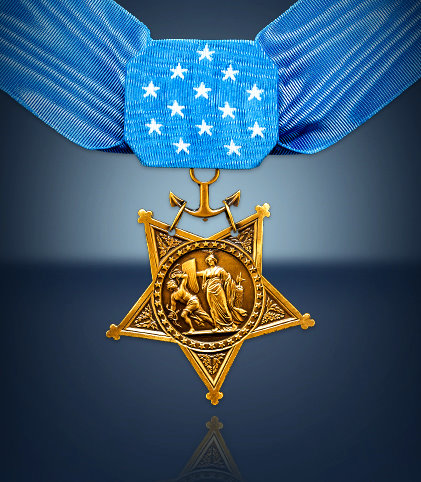

|
|
LT Thomas R. Norris
Awarded the "Medal Of Honor"
|
Name: Thomas R. Norris
|

Navy Medal Of Honor
Awarded Congressional Medal of Honor on March 6, 1976, by President Gerald Ford,
Advisor with the Strategic Technical Directorate Assistance Team,
Contributions Thomas Norris served with extraordinary distinction as a Navy SEAL on two tours of duty in
LT Norris persevered in his repeated night sorties to find and rescue the American aviators,
In 1979, after years of surgeries, LT Norris achieved his life ambition of becoming an FBI Agent.
MOH Citation
ďDuring the period 10 to 13 April 1972, Lieutenant Norris completed an unprecedented ground
On April 11, after a devastating mortar and rocket attack on the small FOB, Lieutenant Norris
Dressed in fishermen disguises and using a sampan, Lieutenant Norris and one Vietnamese
Approaching the FOB, they came under heavy machinegun fire. Lieutenant Norris called in
Biography Thomas Norris was born in Jacksonville, Florida, then moved with his family to Wisconsin and Washington, D.C. He entered the University of Maryland in 1963, with the intent of pursuing a criminology career with the FBI. While in college, he was the Atlantic Coast Conference ACC wrestling champion in both 1965 and 1966. Norris graduated from the University of Maryland in 1967 with a B.S. in Sociology and a specialty in Criminology. He enlisted in the Navy when his student deferment from the draft was not extended. Norris had hoped to become a pilot, but when disqualified due to visual acuity and depth perception problems, volunteered for the Navy SEALs. Norris was on his second SEAL tour in Vietnam when on April 2, 1972 an American EB-66 electronic warfare aircraft was shot down over North Vietnam. Over 30,000 North Vietnamese soldiers were in the immediate area, in the beginning of a pincer-like Easter offensive. One crewman, Air Force LT Col Iceal Gene Hambleton, survived the crash. He knew intimate information about U.S. missiles and targets from a tour at Strategic Air Command, so it was critical that the enemy not capture him. On April 3, two rescuing aviators were shot down; of the two, only LT Mark Clark evaded capture. The Air Force Force launched a supreme effort to recover Clark and Hambleton, which became the most intense and costliest rescue of the Vietnam War. In five days, 14 people were killed, eight aircraft lost, two rescuers captured, and two more stranded behind enemy lines. The 7th Air Force was communicating with Clark and Hambleton, assisting them to escape and evade, but after great losses, realized that a rescue by air was not achievable. On April 8, Marine Colonel Albert Gray, (who later went on to become the Commandant of the Marine Corps), suggested a covert, land-based rescue effort, saying, I have a boat load of guys who would love to do something like that. On April 10, Thomas Norris led five ARVN (Vietnamese SEALs) on a two km overland insertion into dense enemy territory. He located LT Mark Clark at daybreak on April 11th, then floated him downriver in the strong current. Later, the North Vietnamese conducted a devastating rocket attack on their small outpost, killing two of Norrisí original team. On April 12, LT Norris and his three remaining Vietnamese SEALs went 4 km into enemy territory in an unsuccessful attempt to find Hambleton by dawn. Two of the three ARVN were so daunted by the massive enemy forces that they did not accompany Norris on further missions. On April 13th, after Lt. Norris was given Hambletonís location by a Forward Air Controller, he attempted another night rescue with his Vietnamese SEAL comrade, Nguyen Van Kiet. They dressed as fishermen, paddled a sampan upriver, discovered the injured pilot at daybreak, and hid him in the boat under banana leaves. On their return down river to the base, they were pursued and fired upon by an NVA patrol on the bank, and called in air support. They were fired upon again by heavy machine guns as they neared the shore, and got Hambleton to their bunker. Norris administered first aid to the wounded pilot, (who had been on escape and evasion for 11 days), and prepared him for evacuation. Six months later, LT Norris was leading an intelligence and capture mission of one other U.S. Navy SEAL and three South Vietnamese when he was shot in the face and believed killed. SEAL Petty Officer Michael Thornton ran into a hail of bullets, dragged Norris away, and swam him seaward for two hours, saving his life. It was the first time in over 100 years that one Medal of Honor recipient saved the life of another. Both are still alive and well. In His Own Words All in all, Iíve had a pretty interesting life, Norris said a few years ago. Iíve always gone after the challenge. |
Learn more about LT Thomas R. Norris. Click HERE!